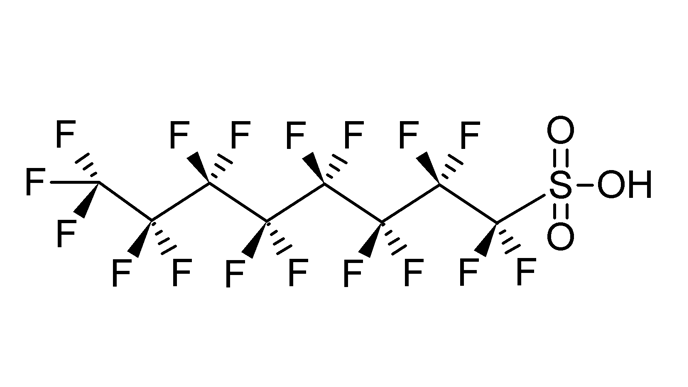
PFAS - research overview
KEY POINTS- Process
- Treatment
- Analysis
Project overview
Participants
More related research
Global goals
- 3. Good health and well-being
- 6. Clean water and sanitation
- 14. Life below water
- 15. Life on land
Short summary
PFAS are synthetic organofluorine compounds known for extreme stability, also called "forever chemicals." Their persistence and bioaccumulation raise environmental and health concerns, with contamination occurring via various human activities that impact aquatic systems.
PFAS are defined as fluorinated substances that contain at least one fully fluorinated methyl (–CF₃) or methylene (–CF₂–) carbon atom, with no H, Cl, Br, or I (OECD 2021). PFAS pose a major environmental and health threat due to their extreme persistence, accumulating in soil, air, water, and the human body over time. Studies link certain PFAS to liver damage, immune suppression, hormonal disruption, and increased cancer risk. Found globally—even in newborns’ blood—PFAS enter aquatic systems through wastewater discharge, landfill leaching, biosolid application, fire-fighting foam use, and surface runoff.
Research activities related to PFAS focus on:
- Source identification and tracing through forensic chemical profiling and monitoring of sources
- Investigating their transport pathways and environmental fate
- Studying PFAS distribution between environmental compartments and understanding factors influencing environmental fate
- Development of advanced remediation techniques for contaminated soil and water systems
- Identification of known and emerging PFAS using suspect and non-target screening methods via high-resolution mass spectrometry
- Supporting regulatory frameworks and early warning systems through evidence-based recommendations and policy-relevant datasets
Current projects on PFAS
- PARC: Partnership for the Assessment of Risks from Chemicals (EU Horizon-HLTH-2021-ENVHLTH-03-01) (co-applicant, Task Leader on Early Warning Systems)
- LIFE SOuRCE: Demonstration and evaluation of Sustainable On-site Remediation technologies for PFAS-ContaminatEd groundwater (co-applicant, WP leader)
- LIFE CAPTURE: Combining novel analytical protocols for PFAS contamination with technologies for sustainable remediation (co-applicant, WP co-leader)
- SIDWater: Sustainable innovative drinking water treatment solutions for large-scale water supply and reuse, Formas (PI Lutz Ahrens)
- PFASMAR: Artificial groundwater recharge – A shortcut for harmful poly- and perfluoroalkyl substances (PFASs) into groundwater systems and drinking water supplies – Can we avoid this? Formas (PI Philipp Wanner, GU)
- DRICKS: Competence centre for drinking water - Projects about Sources, prevalence, and treatment of hazardous chemicals in drinking water, Svenskt Vatten and others
Remediation of PFAS-contaminated soil using air sparging, SGU and SGI (PI Lutz Ahrens) - BioPFAS: Microbial degradation of PFAS for remediation of contaminated soil and groundwater, SGI Tuffo (PI Fritjof Fagerlund, Uppsala University)
Finalized projects on PFAS
- PhytoRem: Phytoremediation of per- and polyfluoroalkyl Substance (PFAS)-contaminated soil and groundwater, SGI Tuffo (PI Lutz Ahrens)
- A novel approach for the removal of per- and polyfluoroalkyl substances (PFASs) in drinking water by engineering metal-organic and covalent organic frameworks, Formas (PI Lars Öhrström, Chalmers)
- Sorption of perfluoroalkyl substances (PFASs) in soils – mechanisms and modelling, VR (PI J P Gustafsson)
- Rest to best: Biochar as solution and product in the circular and climate positive society, Vinnova (PI Lund municipality)
- Blackwater treatment and reuse as agricultural fertilizer, Formas (PI Meri Gros)
- ITN PERFORCE3: Per- and polyfluorinated alkyl substances towards the future of research and its communication in Europe (Coordinator Ian T Cousins, ACES, Stockholm University, WP3 leader Lutz Ahrens)
- Food waste to new food in an urban context: Formas (PI Malin Hultberg, SLU)
- SafeDrink: Integrated chemical and toxicological methods for early detection of hazardous chemicals in drinking water, Formas (PI Karin Wiberg)
- RedMic: Novel strategies to reduce diffuse emissions of micropollutants from on-site sewage facilities, Formas (PI Patrik Andersson, Umeå University)
- PFASs-Free: Innovative treatment techniques for per- and polyfluoroalkyl substances in drinking water, Formas (PI Lutz Ahrens)
- PFASs-PURE: Innovative treatment techniques for per- and polyfluoroalkyl substances in soil and groundwater, Vinnova (PI Lutz Ahrens)
- StopPFAS: In-situ remediation of PFASs based on sorption methods, SGI Tuffo (PI F Fagerlund, Uppsala University)
- NonHazCity: Innovative management solutions for minimizing emissions of hazardous substances from urban areas in the Baltic Sea Region, EU Interreg flagship project (PI Stockholm Stad, Tonie Wickman)
- PFASs-PURE: Innovative treatment techniques for PFAS in soil and groundwater, Vinnova (PI Lutz Ahrens)
- Forest-POPs I: Legacy and emerging POPs in the Swedish forest, Formas (PI Karin Wiberg)
Publications